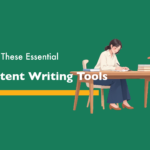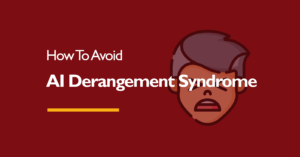I know the feeling all too well: juggling multiple projects, trying to meet tight deadlines, and feeling like there just aren’t enough hours in the day.
Through trial and error and a lot of late nights, I’ve discovered practical strategies that help me write faster without compromising on quality.
So, if you’ve ever felt the frustration of slow progress, the anxiety of impending deadlines, or the struggle to find your writing flow, this guide will help you write faster.
#1: Know your audience before you start writing
What if I tell you that you can halve your writing time when you know who you’re writing for, that is, your audience?
Think about it. When you know who will read your content, you can appropriately tailor your message, skip the fluff, and get straight to the point.
Take this blog post as an example. It was easy to tailor my message because I knew that my audience would be people looking for tips on writing content faster.
Freestyling will only work when you’re journaling or not looking to publish your work; otherwise, know and write for your audience.
#2: Prepare your writing environment
You cannot write fast when you’re lying on your bed, feeling super-comfy and on the verge of falling asleep.
It’s difficult to bring fluidity to your thoughts, which is a crucial aspect of writing, when chatter and noise surround and distract you.
The right environment is highly underrated but incredibly important if you want to create good content faster.
I find that having a dedicated, clean, and clutter-free workspace helps me concentrate. I also make sure that everything I need is within reach—my notes, water, and maybe a snack.
A well-prepared workspace minimizes distractions and helps you focus on the task at hand.
#3: Do research the right way
“Write, research, write, research, write, research.” Does this somehow describe your writing process?
If yes, be aware that this is a flawed way of writing. Not only does it constantly interrupt your workflow, but it also scatters your thought process.
What’s better? Adopt a strategic approach to researching topics.
First, outline the main points you want to cover and then find specific information for each one.
While you’re researching, take detailed notes and arrange them according to your structure so that they’re easy to refer back to when you’re writing.
You must also ensure that your research sources are reliable. Where necessary, cross-reference and fact-check information before moving on.
When the research process is complete and your notes ready, you can then focus on writing a cohesive piece while maintaining your train of thought.
#4: Outline your content
To write faster, consider breaking down your content into smaller sections with separate ideas. I remember struggling with this, too, before learning how to do so.
Create headings and subheadings for specific posts or details, tailor your research to each individual part, and then make them as informative and engaging as possible.
An outline organizes your content and connects your ideas. If you go off-course when writing, an outline will bring you back to the focus of your content.
Say you have a 3,000-word blog post; depending on the context, break it down into 6 small 500-word pieces so writing feels less overwhelming and more achievable.
#5: Work with content templates
The blank page is every writer’s nightmare—it is intimidating. But that’s where templates come in.
Templates are a great way to streamline your writing process. You can either create one by yourself or take advantage of several online platforms that offer content templates.
Think about it: most types of content follow a structure. Even though every new piece of content focuses on a different topic, their structure almost remains the same.
Blog posts, articles, and even social media posts all have a similar anatomy. There’ll always be a title, an introduction, a body text (containing paragraphs, subtitles, etc.), and a conclusion. So, all you have to do is fill in the content.
While templates tend to be generic, you’re not restricted as you can always tweak and edit them to suit your needs and style.
#6: Set deadlines for yourself
You’ll agree with me that deadlines are powerful motivators. Apart from those imposed by clients, I set realistic deadlines for different stages of my writing process, from research to final edits.
Deadlines help me stay on track and prevent procrastination. They also allow me to effectively manage my workload and avoid last-minute rushes, ensuring that the quality of my content remains high.
For a more engaging approach, challenge yourself to write a certain number of words within a specific time frame.
If you enjoy competition, these challenges can make the writing process more enjoyable, faster, and more productive.
#7: Turn off all notifications
Distraction is the enemy of fast writing.
When it’s time to write, turn off all notifications on your phone and computer—no emails, no social media alerts, no text messages.
Find a quiet and comfortable place where you can write without interruptions.
During writing sessions, I put my phone on “Do Not Disturb” and close unnecessary tabs on my computer. This minimizes interruptions and helps me achieve a state of deep focus, increasing my productivity.
#8: Listen to background music
Outside of your writing time, look for writing and focus playlists on Spotify or Apple Music.
Experiment with different playlists while writing, and you will notice that some of them really help you write faster. It tunes out the background noise, gently pushing you forward.
Avoid songs with lyrics that you can sing along to or those that evoke emotional memories. You don’t want to bob your head to Bad Blood when writing about AI sustainability.
Classical music works best for most people, while others prefer white noise or nature sounds.
Personally, my mood influences the music or sound I listen to while writing. Some days, I listen to relaxing piano pieces; on other days, I prefer upbeat tracks. Occasionally, I opt for ambient sounds like rain or waterfalls.
#9: Kill your inner editor
Next to social media notifications, editing your content as you write is another huge distraction.
Stop the habit of making minor edits after every sentence, paragraph, or sub-heading. Just write and keep going, then revisit and edit your work only after you’ve completed the entire piece.
Turn off the spell-check plugin. Deactivate Grammarly for the session.
If your goal is to write faster, editing content during the writing process slows you down and wastes time, as you’ll still need to edit the entire piece again before publishing.
Once the first draft is complete, take a break before returning with fresh eyes to edit. Separating writing from editing can allow you to be more creative and efficient in both stages.
#10: Use writing aids and tools
I advocate writing aids and tools to streamline your work and boost your productivity.
Whether you use MS Word, Google Docs, or software like Grammarly, you have several features and tools at your disposal that can enhance your writing process.
Yet, while I support the use of tools for tasks like proofreading, spell-checking, and grammar correction, I have reservations about relying solely on AI for content generation.
Don’t get me wrong; AI certainly has its uses in writing—even Grammarly uses it for proofreading and suggesting improvements.
However, when it comes to creating the core content that resonates with your audience, you’re better off doing that yourself.
AI-generated content, more often than not, comes off as generic, repetitive, and unconvincing.
So, while AI can provide ideas or outlines, there’s no substitute for the depth, authenticity, and creativity our human experience brings.
#11: Use the Pomodoro technique
The Pomodoro technique is a proven time management method that involves working in short, focused bursts with breaks in between.
For every 25 minutes of work, a 5-minute break follows. You can increase the work time to 30 minutes with 10-minute breaks.
Since I’m all for keeping phones away to avoid distraction, you can set the Pomodoro intervals using a desk timer, a digital watch, or even your computer’s built-in clock.
Alternatively, set your phone to DND and use the alarm app as your timer.
During these intervals, focus solely on writing, knowing that a break is just around the corner.
This system keeps you focused and helps sustain high productivity levels throughout the day, particularly during long writing sessions.
Additionally, regular breaks from work prevent fatigue and keep your mind sharp so you can create content faster.
#12: Seek help from experts at RoninPoint
Ultimately, despite your ability to produce content quickly, it may still not be sufficient to achieve your goals.
Or maybe you lack the necessary expertise or experience to create high-quality content promptly.
No matter the case, rather than giving up on content creation, consider outsourcing it to the experts at RoninPoint.
RoninPoint boasts a team of experienced writers and researchers who deliver fast content without compromising quality.
Our expertise in content strategy and editing spans diverse industries, including technology, software development, healthcare, and eLearning.
Just one trial with us, and you’ll never go back to tackling writing alone.
Interested? Shoot us a quick message to get started.
Is writing content fast a good idea?
Writing content fast is a good idea, but it is more about efficiency and quality than speed.
While you want to produce content quickly and meet deadlines, it’s equally important to ensure that it is well-researched, engaging, and error-free.
Remember, the goal is to find a balance between speed and quality. By incorporating these tips into your writing routine, you’ll find yourself becoming a faster, more effective writer.
Who wrote this?
Joanna is a versatile content writer with a knack for creating helpful content that resonates with others. When she’s not typing away, she finds solace in quiet moments, music, and cinematography videos. She believes she has an untapped well of creativity inside her and she’s willing to dig deep to fetch it out.
- Joanna Alihttps://roninpoint.com/author/joanna/
- Joanna Alihttps://roninpoint.com/author/joanna/
- Joanna Alihttps://roninpoint.com/author/joanna/
- Joanna Alihttps://roninpoint.com/author/joanna/April 20, 2025









